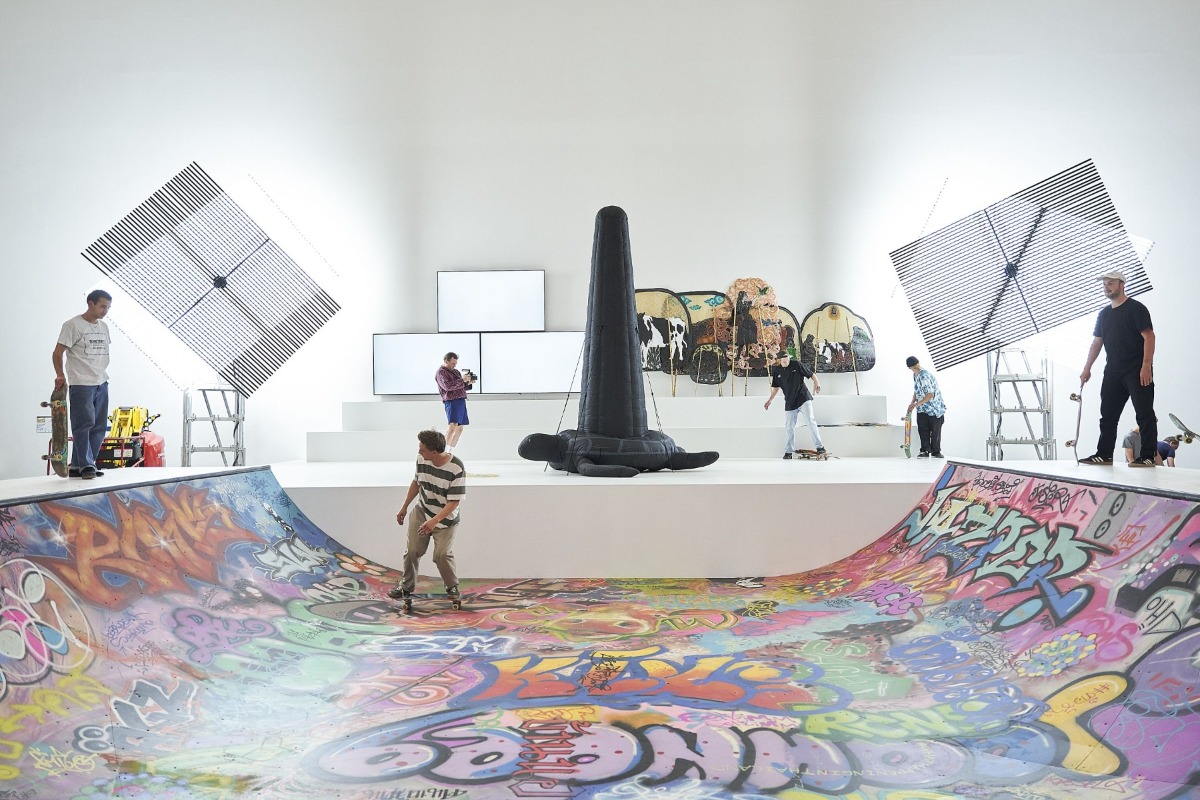
Documenta 15: Whose Side Are You on Anyway?
A review of Documenta 15
It’s 7 pm in Kassel and a crowd of colourful hippies, strived grandmothers and stiff art historians gather to dance after being exposed to multiculti aesthetics that go from the Yoruba alphabet to homemade films in Baghdad and childcare spaces. It is nor Rihanna neither Manu Chao who plays music, but the Volkswagen Mechanics Jazz Band performing in front of the Frederiecanium with a fun, amateur vibe. Before I was curiously observing how a curator —uniformed all black and wearing a cap from a NYC museum— tasted the banana bread offered in the communal kitchen behind Documenta Halle. Alas, this kind of multiuses spaces –for eating, cooking, living, drinking– should not simply be called ‘communal kitchen’, because everything in Documenta 15 is named in a way that you had not hear before. Terms such as pakghor, mejelis, nongkrong, lumbung, inter-lokal, gado gado, hikayat bring up specific aspects of storytelling, bonding, wealth, discussion and of life principles in general.
This gesture of naming things differently does not simply refer to the presence of other languages in the event, but also tries to catch nuances that are often lost when translating things to Western discourses. However, my friend P., who lives in Berlin, makes fun of me for coming to Documenta 15: “Why have you visited the Anti-Semite 2022? I still laugh when reading in the newspapers about their NGO aesthetics. They try to cover up the lack of artistic quality with a lot of ideology”. One doesn’t have to be cooking for others, hold anti-Zionist views, or engage in BDSM or beekeeping to enjoy Documenta 15. I find their proposal genuine and fresh, I reply.
One of the contributions of Documenta 15 is to show how they, in the Global South, choose to represent themselves. That impulse of transplanting and translating is not an easy one, nor for the organisers neither for the audience. In the press room, one faces the impossible effort of aligning Jakarta and Kassel in the two clocks hanging on the wall; they show the time with 5 hours of difference, several worlds away though, with different needs and expectations. Such dislocating effort has to be appreciated and considered while assessing the Documenta 15. Not just because some texts (i.e. Arabic) and artworks (i.e. Roma) are supposed to be seen the other way around, from right-to-left, but also because of the need to unlearn some of our Western framings in order to make room for radically different habits of thought and orders of visibility.
Installation at Hafenstraße 76. Photo: Francisco Martinez
“I wish I would understand everything, but I can’t and this frustrates me. I’m not used to see exhibitions that are so different. This Documenta is not made for the pleasure of audiences. But I am happy I came, despite all what I read in the German media”, says L., a curator from Hamburg, who drove to the south a week before the programme ends. J., another friend from Berlin observes: “usually I have no patience for these things, but after spending sometime there, it’s actually ok, even fun. You simply have to accept that they have put little interest in the audience and it looks a bit like NGO art”.
In Kassel, I also meet M, a colleague from the local university who explains: “The German media has made a big fuss around the anti-Mossad symbols, but it failed to be critical about the limits of the global south discourse. This Documenta takes place in the centre of Europe and it is paid with Western money. From private companies to Embassies, from sponsors to political parties, they all try to put forward their own agenda while supporting an artist working in Tunisia or Indonesia. Besides that, it could have been more humoristic. Sometimes it feels a bit too serious”.
Venice Biennale curator Cecilia Allemani says that curating a biennial is “80% logistics”. In the case of the current Documenta, nearly 1500 people are contributing to the different exhibitions and events; a pure anarchic bliss that was not free of disagreements and complications with visas. For the 59th Biennale, Allemani claimed to be re-writing art history from a feminist perspective. In Documenta 15, we see that ruangrupa is practicing art future from a social point of view instead of a purely aesthetic one – making room, time and resources for others to be used in their creative endeavour. Specially for those who have not been included in Western art histories and in political decision making. This art event does not lull you into a dream state, as the Biennale did; It wakes you up, it makes you daring. Perhaps more importantly, it tries to change the rules of the game of art and make you aware of what collective art-making means.
And how is that done? With de-centralised curating based on rhizomatic organising and with art-documents taken as the artistic object, turning Documenta into an open resource for many art collectives. All the artists come from non-Western cultures and their proper names are practically unknown. In terms of production, Documenta 15 had a budget of 42 million euros (Documenta 14 costed over 46 million euros). In keeping with ruangrupa’s ethos of lumbung – the Indonesian word for a communal rice barn, a place surplus harvest is stored for the benefit of all – the artists got an equal share of the production budget as well as a separate pot for collaborative projects (such as a publishing house and a radio). This uncommon curatorial decision enacts an alternative economy of collectivity building. Separately, a share of Documenta’s ticket sales sponsor a small arts festival in a Sumatran village and when artworks are sold, the money is used to finance social projects in their home countries.
We can say that Documenta was invited to be part of the ruangrupa ekosistem, and not vice-versa. That approach was not free of incidents and misunderstandings, since those supporting the event are German tax payers and Western institutions with diverse geopolitical agendas after all. As a result, offensive symbols and a statement out of context were used to discredit the whole proposal, attempting to discipline and lecture ruangrupa in a form of epistemic re-colonisation. Despite being known for their indisciplinarity, still ruangrupa publicly apologised and explained that SS symbols and caricatures of Orthodox Jews were used in relation to the Suharto’s military dictatorship. Such symbology is indeed offensive (specially in Germany), yet this incident also exemplifies a collision of sensibilities and the “multidirectional memory” that histories of extreme violence might confront, expressing something different in Europe than in Indonesia.[1]
Fondation Festival sur le Niger, Yaya Coulibaly, The Wall of Puppets, 2022, installation view, Hübner areal, Kassel, June 13, 2022, photo: Maja Wirkus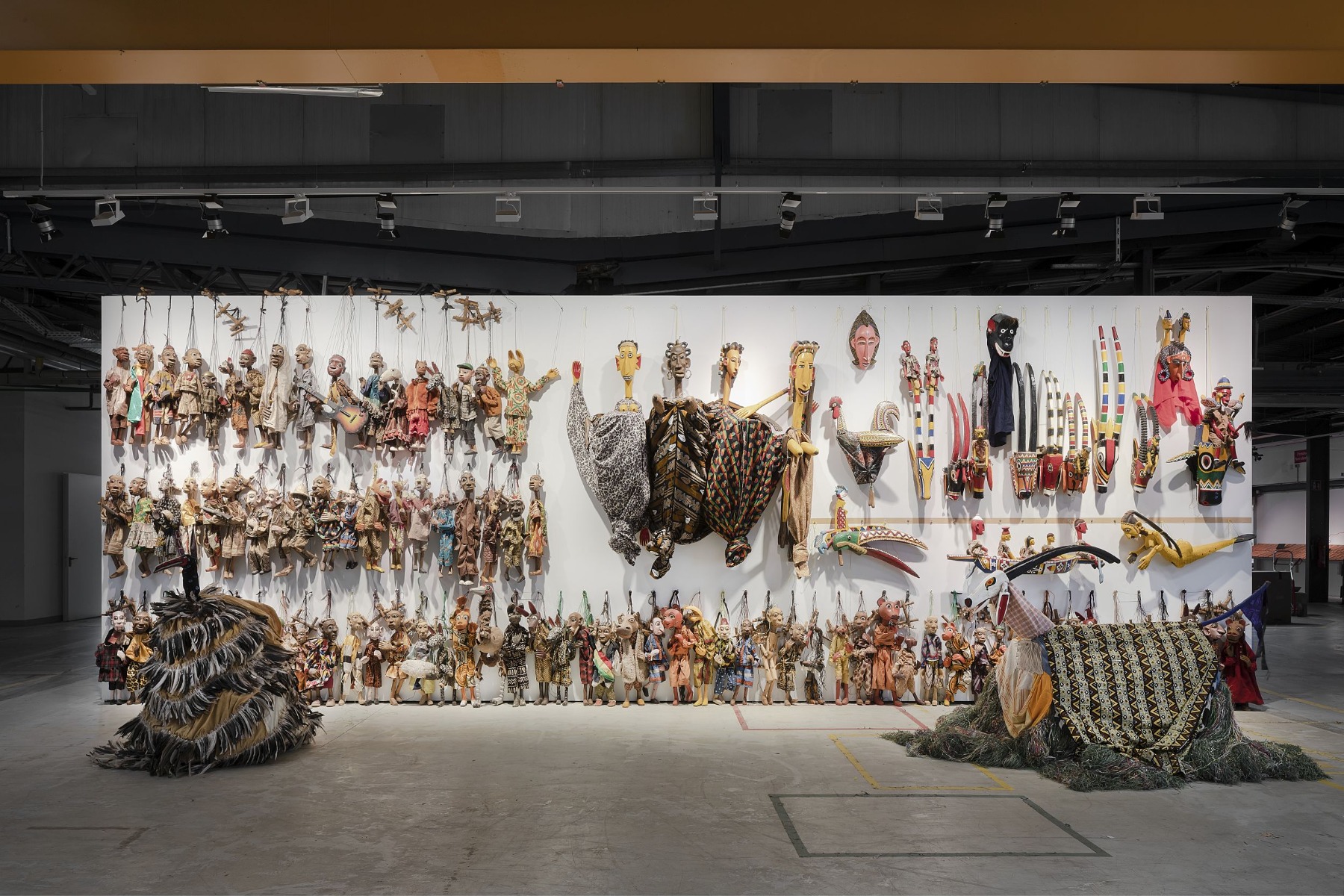
On the queue to enter the Hübner Areal, perhaps the most complete venue of the programme, I talk to J., who says to be “shocked. I have discovered how many struggles other artists, other people, have in their home countries. It made me realise how privileged I am to live in Halle”. A few hours later I was playing music for lumbung radio in the St. Kunigundis church, where I talked to N., who wears a t-shirt with the flag of Israel. “As a German, I feel obligated to express my support to the state of Israel and my disagreement with the curatorial statement of Documenta 15”. Did you have any problem by doing so? “No, no one asked me about the t-shirt so far, only you. It’s been actually quite interesting and fun”.
Jakarta-Kasse at the Press Room. Photo: Francisco Martinez
Indra is a member of ruangrupa and says that this year he had travelled Jakarta-Kassel five times because of the need to renew his visa. We meet in a party celebrating the birthday of his wife. It’s a bar behind the Grimmwelt museum, where the guests bring their own drinks. “Before the opening, it was very difficult to meet and work with the artists because of the pandemic. Then, after the opening, it was difficult to stablish a common ground with so many and so different participants and institutions. Different worlds brought together. Perhaps the organisational aspects have been the most difficult. But here, in the ground, it has been fun”.
“We have created a knot”, then cheers a Mexican artist, joining our conversation. A nonkrong knot, making friends and connections by entering into spontaneous conversations.
The social is not a catwalk, nor a post on Instagram
The social might be chaotic, messy, noisy, capable of clumsy statements and aesthetics; certainly unmanageable, but still needed to generate wider transformations. In Documenta 15, ruangrupa explores what collective art might be by creating an ekosistem–a mess of collaborative network structures that differs from Western notions of participatory and relational art. Horizontally, it brings different worlds together (not audiences or content) and it produces archives – here taken as devices to share ideas as well as to facilitate participation. They do so politically by making visible the needs of those who have no voice in European public discussions, claiming for the right to social infrastructures and self-expression.
Sebastián Díaz Morales & Simon Danang Anggoro, Smashing Monuments and Sleepers, 2022, Hübner areal, 2022, Kassel, July 4, 2022, Photo: Nicolas Wefers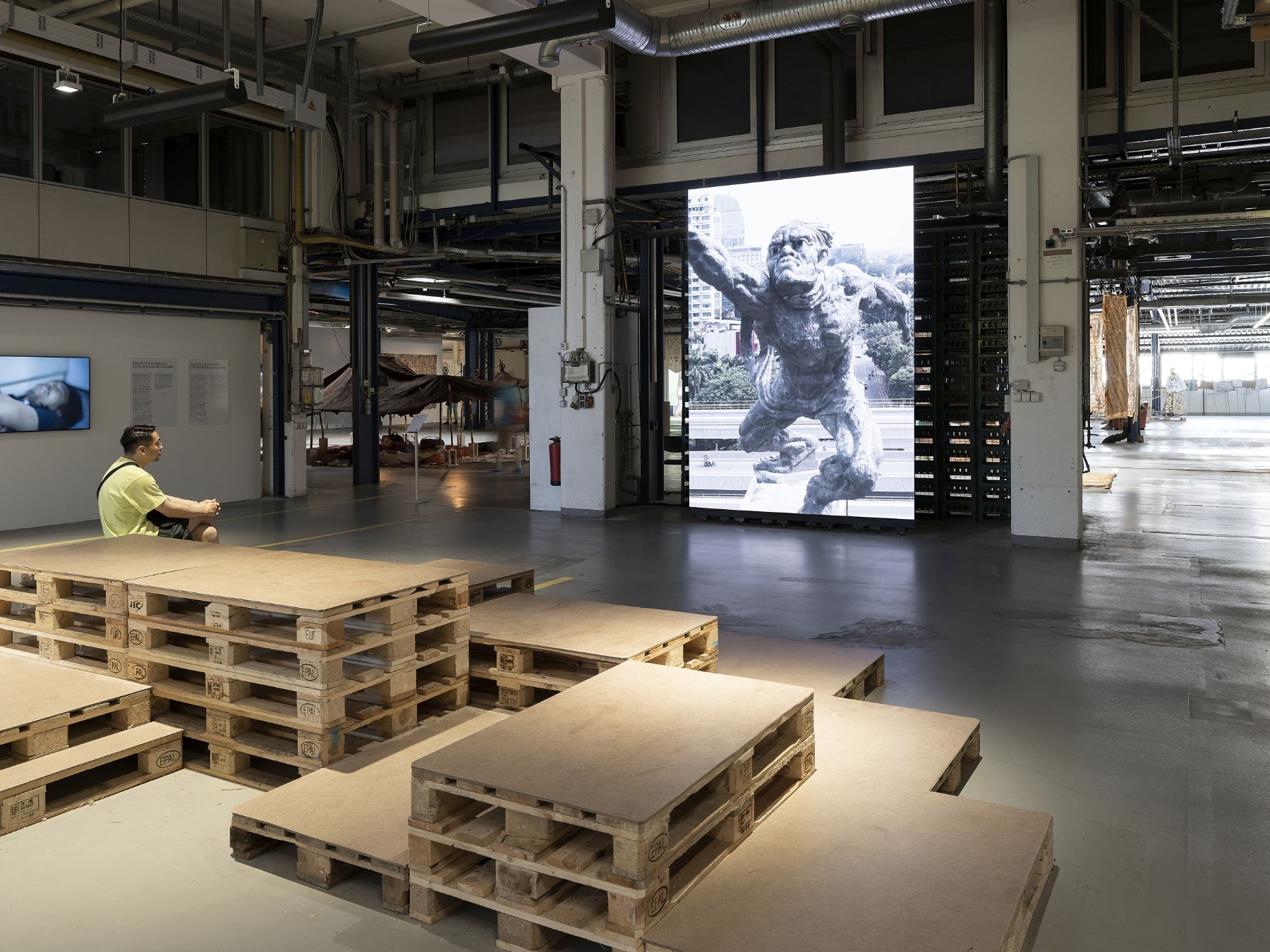
As it happens in any big art event, some artworks are more interesting than others. Here, one has to apply the same economy of attention than in the Venice Biennale. Since ruangrupa is not interested in pleasing audiences, filling galleries, selling to collectors, and providing content, not everything in Documenta 15 is translated, there is way too much text and some of the artworks are ephemeral. To understand them, it might help if we accept that we can enjoy an artwork despite not understanding it to the end. Otherwise, we can also try to unlearn some of the epistemic tools we use to approach non-Western projects, instead of just assuming “there is no art”.
In Documenta 15, the top-down (often Eurocentric) model of single-to-many, with the eminent curator presenting vertically a fanciful and authoritative view of the latest developments in contemporary art, is challenged. Instead, ruangrupa has made way for a more horizontal structure in which social embeddedness matter more than the museistic object and expertise. The gesture consists in establishing a many-to-many conversation, extending the imagination of what is art and what is relevant in addressing contemporary issues. This is not all that new and at previous Documentas, several artists have explored experimental collective practices. For instance, in 1982 Joseph Beuys presented 7000 Oaks, a work that placed seven thousand blocks of basalt in front of the facade of the Fridericianum. At one end of the block pile, he planted an oak tree and ask neighbours and visitors to only remove the blocks if a tree were to be planted. All the 7000 trees were planted and the site has been designated national heritage. In 2002, Thomas Hirschhorn moved into a local housing complex and autoconstructed with the neighbours a booth that served as a bar, library and TV studio. In 2012, Theaster Gates, restored a derelict hotel, bringing both material and builders from his home city and organising different events there. And Ai Weiwei brought 1001 Chinese citizens to Kassel and invited them to roam around.
Installation at the Fridericianum. Photo: Francisco Martinez
Documenta 15 was an open-ended, evolving knowledge-event on a grassroot level, instead of catering to the expectations of contempt audiences and the Western cultural elite. The whole arrangement, irreverent and non-hierarchical, challenges the Western museological understanding of biennales and art fairs. Not every art project has to be socially engaged, progressive or politically critical, but there is a need to embrace experimentality and horizontality to intervene in the crises of the moment. Collaborating itself operates in a test mode, it is intrinsically experimental, depending on the agency of others. Indeed, the rhetoric sharing is a key facet within contemporary media life, be it links, images, status updates, etc. Sharing is, in this sense, a crucial part of our participatory culture, but it also hints at practical boundaries, exclusions and resource allocation.
A year ago, in a discussion with Corina Apostol, I claimed that it’s unfair to ask artists to resolve structural problems, a recipe used by neoliberalism to transfer risks and responsibility to individuals. Alas, we should demand from art institutions to place social wellbeing and progressive values at the centre of their work, besides being self-reflective about their social responsibility. After all, art institutions are part of the political system that produces some of our current problems (i.e. pollution, inequality, segregation); also they are often supported by public funding, which turns social responsibility into an imperative. Art institutions have the means to transform things by making certain issues visible, by being inclusive and participatory in terms of decision making (and job opportunities), as well as by making time, space and resources to different so-called minorities. In my view, to be political means to enact alternative forms of organising our work, reconsidering the when, where, with whom and who benefits of what we do.
Atis Rezistans | Ghetto Biennale, installation view, St. Kunigundis, Kassel, June 14, 2022, photo: Frank Sperling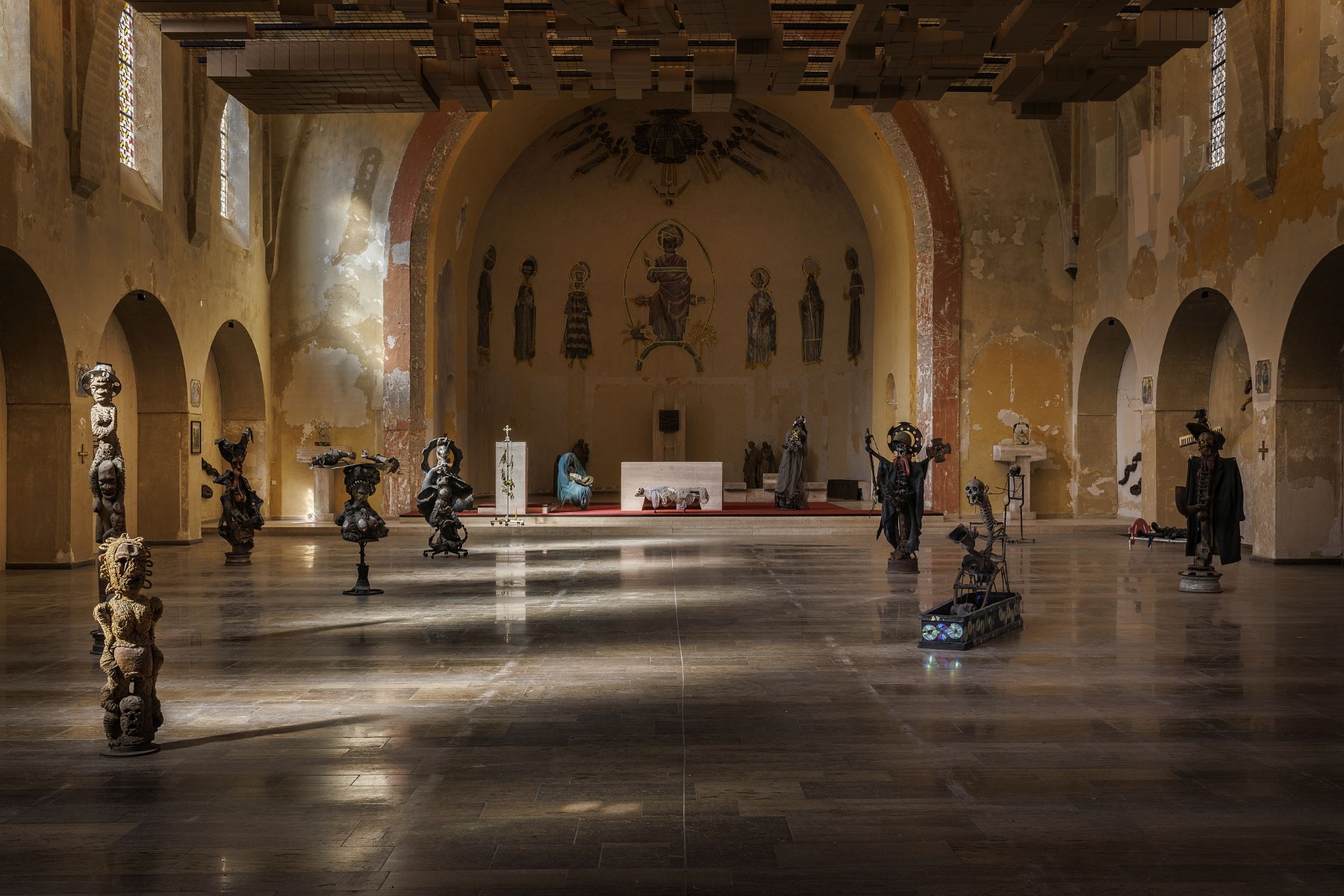
Contemporary art does not have to be useful, but relevant to art discussions: aesthetically, commercially, socially. Otherwise, judging this Documenta 15 by the same criteria we use for Western exhibitions is missing the point, looking but failing to see. Ruangrupa propagates the art of collaboration, soliciting accomplices, not collectors. As a result, Documenta 15 does not display instagramable objects; rather it shows that anyone can be an artist notwithstanding their education or affiliation, as previously done by Duchamp, Ukeles or Banksy. In this Documenta, it’s hard to highlight the name of single artists, since the whole programme is curated as a collective artwork in itself. Nonetheless, I was specially touched by two projects: Ngunyen Trinh Thi’s ‘And they die of natural death’ and the Atis Rezistans & Ghetto Biennale revisit to the death culture in Haiti. In the former, one steps through a thick wall into a humid darkness to perceive the victory of a human over a detention camp; Inside, the artist has lit a series of chili plants, whose shadows are projected to the stone walls. An eerie soundscape of sáo ôi flutes sounds ever so often, based on how the wind actually blows in North Vietnam, where the artist was detained. Atis Rezistans, in turn, is a group working in Port-au-Prince. They have installed a series of beautifully morbid sculptures in the St. Kunigundis church, mostly made by un-noble elements and modern leftovers.
Nguyễn Trinh Thi, And They Die a Natural Death, 2022. Installation view, Rondell, Kassel, June 14, 2022. Photo: Frank Sperling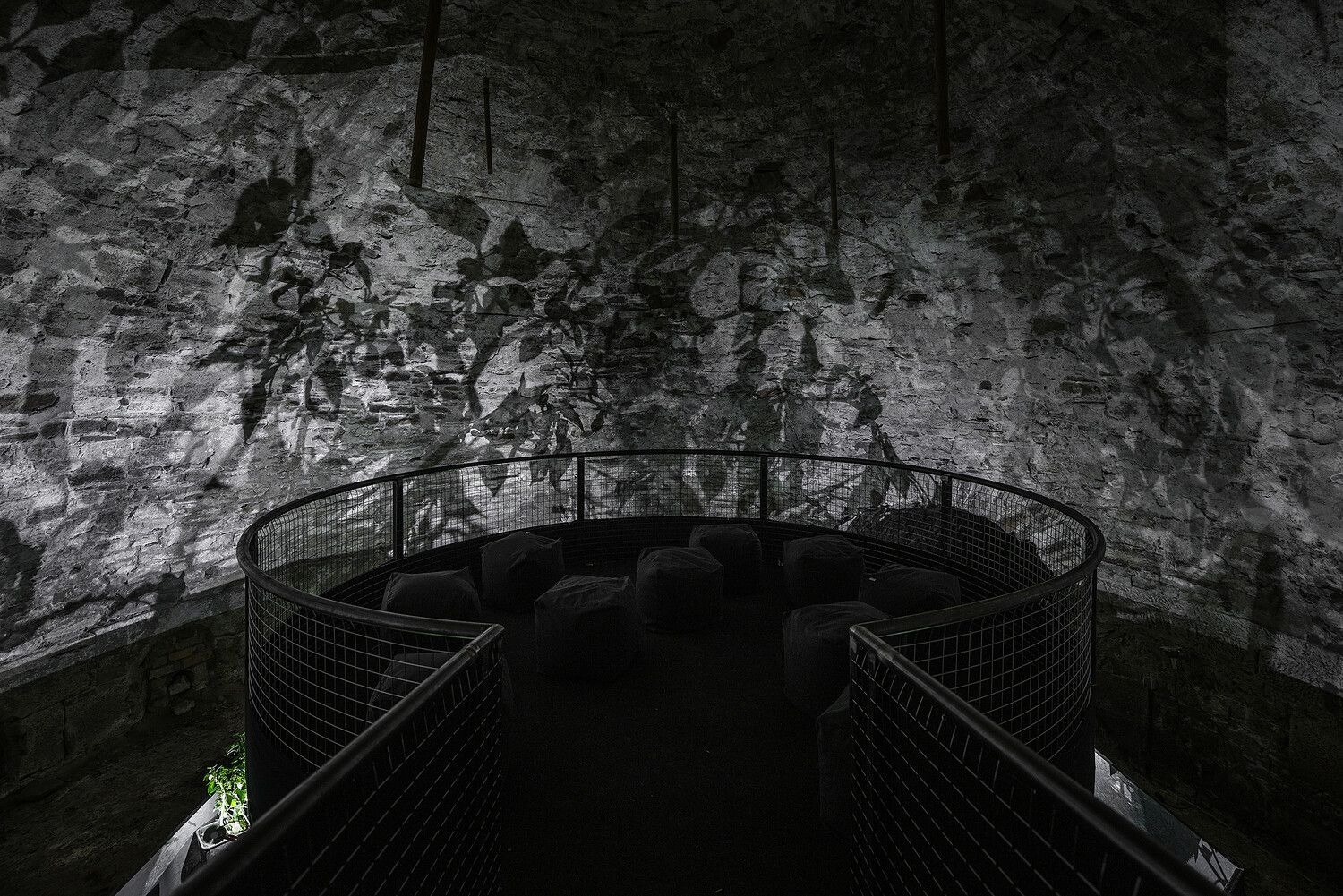
Documenta 15 shows that we need to find ways to reconceive what we’re doing, with whom, what for and also who benefits. As we also saw in the Venice biennial, the art market (which focuses on creating profit) and art practices supported by public funding are drifting apart, expanding the gap between art and life. They have increasingly different agendas and responsibilities. However, in the Estonian art field, only one of the sides is strong – favouring the commercialization of the artistic object and the institutionalization of artistic manifestations.
I believe that we can learn from the critical, open-ended, archival-oriented community-building effort of Documenta 15. I wish there were more ruangrupalumbung-kind projects in Estonia, tinkering with spaces, publishing and networks.
[1] Rothberg, M. 2009. Multidirectional Memory. Standford UP.
***
Francisco Martínez is a Visiting Professor of Social Design at the Estonian Academy of Arts
Title image: Baan Noorg Collaborative Arts and Culture, The Rituals of Things, 2022, installation view, documenta Halle, Kassel, June 13, 2022, photo: Nicolas Wefers